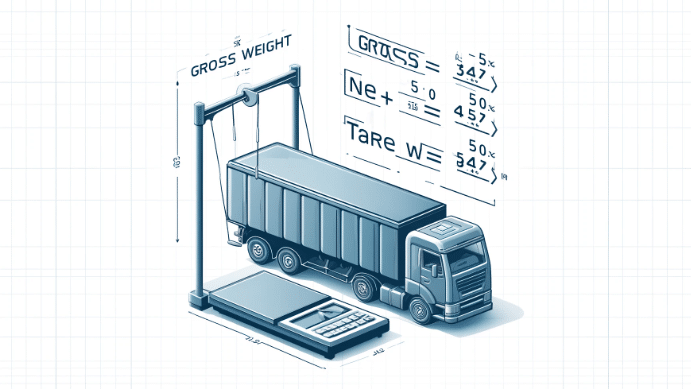The essential part of executing any successful business is shipping and cargo. Do you know how to calculate cargo weight accurately? Well! Net weight, tare weight, and gross weight are the important terms used in the shipping industry, ensuring you don’t pay excessively for shipping costs. Hence, if you play a role in shipping, then this article will help you to understand the key difference between net weight vs gross weight vs tare weight. Additionally, keep on reading to learn how to calculate your tare weight for maximum efficiency.
The Importance Of Shipping Weights:
Weight plays a crucial role in determining freight class. Shipping weights have the utmost importance in logistics to ensure a safe shipment. Therefore, to make an informed decision related to your shipping costs, having accurate weights is important.
You might face serious consequences for incorrect weights like cargo impact protection, moving concerns, and freight company penalties. To avoid safety issues and disputes about shipping costs, shipping weights are crucial.
What Does Net Weight Mean?
The weight of the product or item is referred to as the net weight. The weight of packaging and container weight is not involved in net weight. It is beneficial to determine the cost of shipping and the safety of the shipment.
For example, sometimes special packaging materials and other safety measures are required for the safety of the shipment, and your heavier packages typically incur higher shipping fees.
Example of Net Weight
Let’s understand net weight more efficiently by considering the following example: Suppose we have 3000 pieces of small electronic devices, having 150g weight of each unit or device. To calculate the net weight, you can use the following formula
Net weight = number of products X weight of the product(s)
3000 x 150 g = 450,000 g or 450 kg
Hence, 450 kg is the net weight of the product that we shipped. By adding the weight of the vehicle and other accessories, a true weight calculation can be discovered.
Also read: What is a Delivery Exception, How to Prevent it & What to Do if it’s Inevitable
What Does Tare Weight Mean?
When we refer to the mass of an empty container, wheel, or any other vehicle without any shipping load, then this weight is called tare weight. The term ‘’Unladen weight’ is also used to describe tare weight. Tare weight is important when we want to get gross chargeable weight.
In addition, tare weight affects the cost of your shipment. Heavier shipments with higher tare weight generally lead to higher costs because tare weight contributes to the overall weight being shipped. Conversely, a lower tare weight can result in a lower shipping rate.
Example of Tare Weight
Your shipment’s gross weight is 5000 kg, and the net weight is 2000 kg. By using the tare weight formula you can get 3000 kg, which is the weight of the container.
Tare weight = gross weight – net weight
5000 kg – 2000 kg = 3000 kg
What Does Gross Weight Mean?
Gross weight signifies the total weight of the loaded items, plus the weight of the vehicle and packaging. In other words, we can say the combined tare weight and net weight provide you with a gross weight that depends on different variables such as type of vehicle, products loaded on it, and weight of the shipping itself.
Moreover, it is a crucial and useful metric in the shipping industry. It has great importance in cargo handling. Handlers use specialized handling equipment to secure the load.
Example of Gross Weight
To understand the term gross weight let’s dive into the following example: Let’s say you wish to transport a 1000 kg shipment of food items. Concerning the product shelves, there are none; the packing weights are around thirty kilograms. In contrast, the container weighs 2000g.
Gross weight = product net weight + packaging weight + product shelf weight + container weight
By putting the number into the above formula you can get the gross weight for the entire shipment like
1000 kg + 30 kg + 2000 kg = 3030 kg
How Is Tare Weight Being Calculated?
Do you want to calculate the tare weight of your shipment? Well, shipping companies like LTL trucking company in Canada, and carriers be aware of their shipping boxes or containers. You can also calculate the tare weight if you are familiar with the gross weight of your shipment.
Tare weight = gross weight – net weight
See the above formula which indicates that awareness of gross weight and net weight is essential to find the tare weight calculation. As mentioned earlier, each container has to have a plate stating its weight when empty.
When you subtract the net weight from the gross weight, you can get the tare weight of your shipment. Pallets, cases, or crates are examples of containers that have their own weight, called tare weight.
Net weight is the mass of all items and gross weight refers to the weight of the products and packaging plus the weight of the container as well.
Tips for Accurate Freight Shipping Weight
Take into account the following key points to ensure accurate freight shipping weight and prevent costly billing adjustments.
- You should use accurate and reliable weighing scales or equipment to get the accurate weight of your shipments.
- Do not estimate the value and don’t rely on outdated measurements.
- You must consider the boxes, pallets, and shrink-wrap weights when measuring freight weight.
- In addition, communicate clearly to provide precise weight information to the shipping center.
- When creating a Bill of Lading, you must give clear information to your shipping carrier.
- Before finalizing the shipping documents, openly check the weight to avoid miscalculations.
- Keep an eye on freight class and density to understand the relationship between them.
- Shipping expenses may be minimized by optimizing the thickness of your shipments, which will decrease your good’s class.
Wrapping Up
In short, the understanding of various types of shipping weights and how to calculate them is crucial. As you see, for shipping purposes, tare weight, gross weight, and net weight are the most important constituents in calculating the total weight of the shipment. We hope this comprehensive article gives you a better understanding of how to calculate these weights effectively, so you can avoid paying excessive shipping costs. Use this valuable information and pay the right amount for shipping.
Inbound Logistics, a leading company or transport broker Quebec, provides useful information to our clients and carriers regarding their needs. We are committed to providing you with scalable solutions to support your business success. To increase efficacy and prioritize cost savings, take total control of your import logistics and transparency. Count on us to get more assistance with your transportation needs. We are always here for you!






